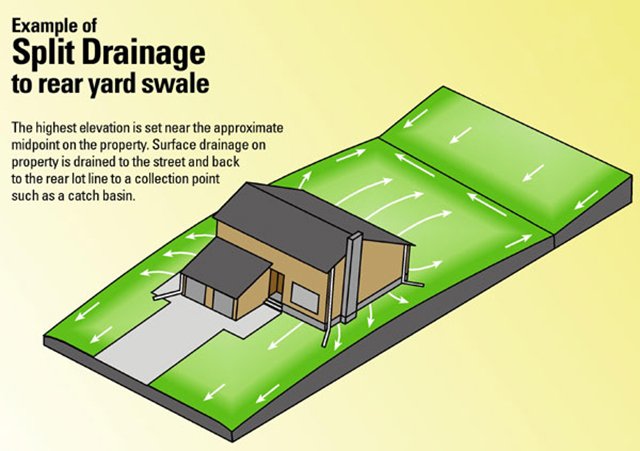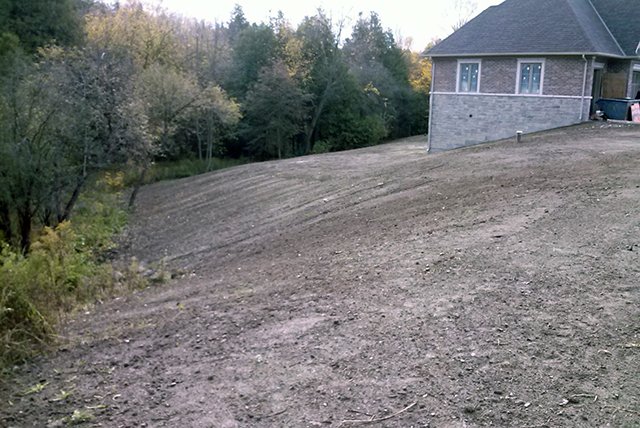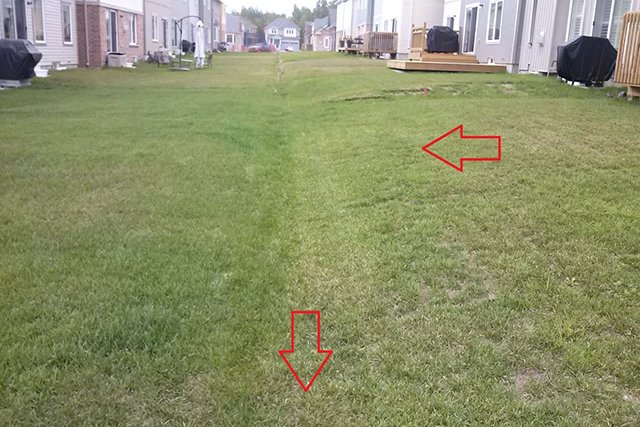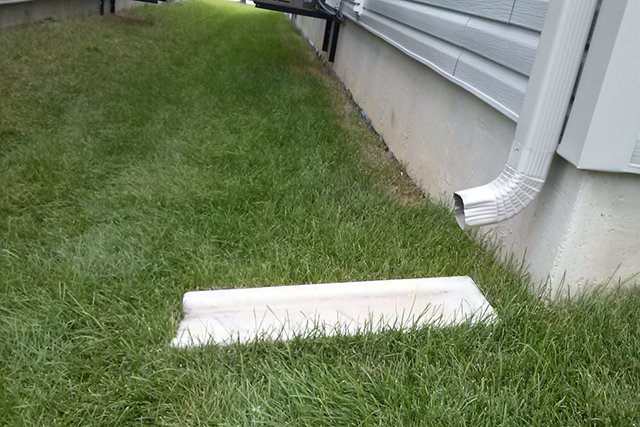
The Town of Whitby's Property Standards By-law regulates grading and drainage on properties within Whitby in order to protect homes and properties from flooding. As a property owner, it is your responsibility to ensure that the grading on your property:
- Prevents excessive, recurring ponding of water
- Prevents water from damaging structures
- Doesn't interfere with the proper functioning of a swale, ditch, culvert, catch basin or other drainage system
Changing the grading or drainage on your lot
According to our municipal by-laws, you're allowed to change the grading and elevation on your lot as long as the:
- Changes don't result in water ponding on your property or a neighbouring property
- Overall drainage pattern in the neighbourhood remains as designed
Drainage is generally directed to public roads or infrastructure or it maintains the original pre-development drainage. Depending on change, you may need to apply for a site alteration permit.
Concerns about your neighbour's drainage or grading
If you have concerns about a grading change that your neighbour has made to their property, we recommend that you speak directly to your neighbour and explain the impact this change is having on your property. For example, you may be experiencing ponding water. Try to work with your neighbour to find a solution.
You may be able to solve the problem by making minor changes to your own property. If this doesn't work, you can file a by-law complaint.
Please take detailed photos of your property to demonstrate the impact of the grading change and include the photos with the complaint.
Request a site plan
If your subdivision was approved after 2016, you'll receive a site plan that shows lot grading from your developer. Please reach out to the developer for a copy.
If your subdivision was approved before 2016, contact us to request a copy of the site plan. Please include the following information with your request:
- Your name (name of the registered property owner)
- Property address
Protecting your home and property from rainwater
Please review these general tips to help protect your property from rainwater.
Avoid disturbing or altering the ground near property lines |
|
This area is often where drainage swales are located so altering this area could impact your drainage. Some common mistakes made by properties include adding the following elements near your property lines:
These elements can block or eliminate drainage swales leading to flooding on your property. We recommend that you don't make any changes to your property within 60 cm of the property line. If you do want to make changes to this area, you should contact a professional landscaper or engineer. |
Regularly cut, trim and rake grass and weeds along the edges of your property |
|
Drainage swales that are filled with long grass, weeds or discarded grass clippings can become less effective and in large rain events may become overwhelmed by the volume of rainwater. Swales filled with long grass and weeds tend to remain saturated for long periods. |
Speak with your contractor about lot grading and drainage before beginning a major construction project |
|
If you are considering a large construction project on your property such as a raised patio or swimming pool, make sure you speak with your contractor about lot grading. If you are unsure about the drainage pattern for your lot, you may contact us or give us a call at 905.430.4307. We can provide you with drainage pattern information for your area. All construction projects need to meet the drainage provisions within the Town's Property Standards By-law. Failure to comply could result in a fine. |
Fill in low spots on your property |
|
If your property contains low spots that may cause ponding, you may want to fill those spots with soil. Before adding soil, you should consult with a professional landscaper or engineer to make sure that adding soil won't obstruct or block the drainage pattern on your property or a neighbour's property. |
Types of drainage patters
Generally, all lot drainage types can be categorized into two different patterns:
- Rear to front drainage
- Split drainage
For split drainage lots, the front of the lot is drained to the municipal road fronting the property while the rear of the lot is drained towards the rear of the property. This usually means that a portion of the rear drainage will enter onto neighbouring properties that use rear to front drainage. For rear to front draining lots, the entire lot is drained to the municipal road fronting the property.
Apron swales |
|
In a rear to front draining lot, there will be an apron swale, which is usually 3 m to 5 m from the back wall of the house on the lot. This swale runs parallel to the back wall of the house across the width of the property and connects to side yard swales, which direct flows to the road.
Photo Credit: City of Winnipeg, Water and Waste Department |
Sheet drainage |
|
All lot surfaces are designed and constructed to convey drainage in a particular direction away from the house; this is known as the slope or grade. Sheet drainage allows rainwater to flow to a lower elevation with the ground absorbing some of rainwater as it flows. This process is known as infiltration.
|
Connected swales |
|
For urban subdivisions, the lot sheet drainage is typically directed to swales on the common property line. A swale is a shallow "V" shaped channel in the ground that collects the sheet drainage flows and efficiently directs the flows to an appropriate outlet, whether it be a public road or other infrastructures such as rear yard catch basins. Most swales run along the entire distance of shared property lines and usually extend about 60 cm onto each side of the property line. On larger subdivision lots, the use of swales may not be necessary if the property can drain effectively by use of sheet drainage alone.
|
Eaves troughs and downspouts |
|
In the Town of Whitby, front downspouts are typically connected to the storm sewer system while rear downspouts are drained to splash pads. There is an exception for townhouse units where the rear downspouts are also connected, or when special requirements are necessary for the subdivision, such as water balance requirements. Rainwater and melted snow falling on the roof of a home is collected by the eaves troughs and directed to the ground by downspouts. Downspouts may be connected into the storm sewer or may drain directly onto the property. If downspouts are not connected to the storm sewer, they should run into an extension pipe and/or splash pad to keep water moving away from the home.
|
Townhouse drainage |
|
In new townhouse developments, typically all downspouts are connected to the storm sewer system. For drainage, townhouses use split drainage, with rear yard swales, which direct water to rear yard catch basins. In townhouse developments, it is particularly important that you don't alter the swales on your properties and maintain the original drainage patterns. |
Contact Us








